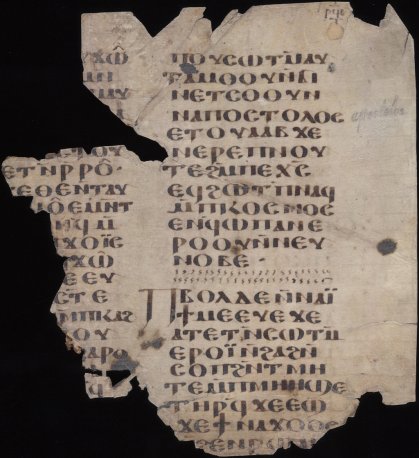Parchment Leaf from the Library of Shenoute's White Monastery
Overview
Parchment Leaf from the Library of Shenoute's White Monastery [ edit ]
After Alexander’s conquest of Egypt in 332 B.C.E. and the establishment of a Macedonian (Greek) dynasty in Alexandria, much of the elite communication of Egypt was now conducted in Greek. But Egyptian remained the language of everyday life for the indigenous people of Egypt. In addition, Egyptian continued to be used in religion, literature, and some legal transactions, written in traditional non-alphabetic writing systems (such as Demotic) that were ultimately based on hieroglyphs.
Within this bilingual milieu, some tentative experiments were made to write the Egyptian language using the Greek alphabet (so-called Old Coptic). But it was not until the third century CE that a consistently standardized alphabetic notation emerged—what modern scholars call the “Coptic alphabet.” In addition to the standard Greek characters, Coptic employed several additional letters, ultimately derived from hieroglyphs, so as to better represent the phonology of Egyptian.
The stage of Egyptian in which the Coptic alphabet was used is called the “Coptic language,” that is, the Egyptian language as spoken and written in the Roman and Byzantine periods of Egypt. In addition to providing a new and convenient spelling system, Coptic also enriched the Egyptian language with large numbers of loan words borrowed from Greek. Various dialects of Egyptian are attested in Coptic, some even with their own variant of the alphabet.
Coptic continued to be spoken until about 1000 CE, when Arabic supplanted it as the everyday language of the Egyptian populace.
The Coptic alphabet and spelling system was first used to translate the Christian bible into Egyptian, and thus it must have been a creation of Christian scholars, perhaps missionaries, in the great learning center of Alexandria. But Coptic writing soon came to be used for all manner of mundane communications, in settings both formal, such as business contracts and administrative records, and informal, such as personal letters and magical spells. Such documents were often written on sheets of papyrus, as here, but other writing surfaces like broken pottery, wooden tablets, parchment, or bone were also put to use. The written record of the transactions of daily life continues into the Coptic period, offering a rich picture of private life.
In contrast to the diversity of the documentary record, works of literature in Coptic consist almost exclusively of texts needed to run a church or monastery. The parchment fragment shown here belongs to a work of Shenoute (347-465 CE), the leader of a federation of monasteries near Atripe (modern Sohag) and the most important author in the Coptic language. It is a parchment leaf belonging to a book in “codex” format—our normal shape of a book with pages that turn and covers that open and shut. This format was invented more or less contemporaneously with the creation of the Coptic alphabet, and replaced scrolls for the copying of literary works.
The formal layout of the Coptic text on the page of a codex and the use of philological signs follow Greek literary practice. In this leaf, the text is arranged in two columns, with line-initial letters occasionally offset to the left (ekthesis, as in column 2 lines 2, 7). A notation at the upper right indicates the page number; as in Greek, alphabetic characters also stand for numerals, hence denotes page 199. One may also observe the use of circumflexes (column 1 lines 1, 12), tremas (column 2 line 13), and superlinear strokes (column 2 line 9). The abbreviated nomen sacrum (for column 2 line 7) occurs within a quotation from the Coptic New Testament: “In Christ God was reconciling the world to himself, not counting their trespasses against them” (2 Corinthians 5:19, NRSV). A double row of ornaments and a projecting, enlarged initial letter (column 2 line 13) mark the beginning of a new work by Shenoute, entitled “And Furthermore I Think.”
Shenoute’s literary corpus was copied in the library of his monastery until at least the eleventh century, amounting to hundreds of codices within a library that once contained more than a thousand volumes—rivaling in size the largest western libraries known at this time.
Period
7th-8th Centuries CE(?)
Dimensions
H. 18.5cm, W. 20cm
Provenance
Sohag, Egypt
Material
Parchment
Museum
Beinecke Rare Book and Manuscript Library
Accession Number
MSS Coptic 2, folio 2
Atiya, Aziz S., ed. The Coptic Encyclopedia. 8 vols. New York: Macmillan, 1991.
Emmel, Stephen. Shenoute’s Literary Corpus. 2 vols. CSCO 599-600. Louvain: Peeters, 2004.
Orlandi, Tito. “The Library of the Monastery of Saint Shenute at Atripe.” In Perspectives on Panopolis: An Egyptian Town from Alexander the Great to the Arab Conquest, edited by A. Egberts, B. P. Muhs, and J. van der Vliet, 211–232. Leiden; Boston: Brill, 2002.


